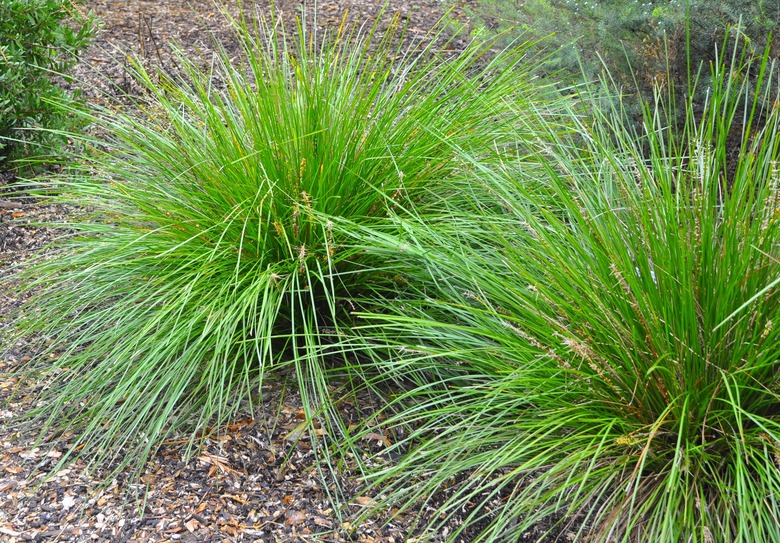The Best Time Of Year To Split And Transplant Ornamental Grass
The best time of year to split and transplant ornamental grass depends on whether the grass is cool season or warm season. The term "ornamental grass" covers a wide variety of perennial and annual plants with narrow foliage, which can be used in landscaping or as grass lawn alternatives.
Perennial types, such as Gracillimus Eulalia grass (Miscanthus sinensis 'Gracillimus'), which is hardy in U.S. Department of Agriculture plant hardiness zones 5 through 9, can be split and transplanted in either spring or fall to reduce congestion or to create new plants. The timing of grass splitting or division depends on whether the grass is a cool-season variety or a warm-season variety.
Tip
The best time to divide and transplant cool-season ornamental grass is early fall once summer temperatures cool off. For warm-season ornamental grass, the best time to divide and transplant is very early in the spring as soon as the ground becomes workable.
Cool-Season vs. Warm-Season Grass
Cool-Season vs. Warm-Season Grass
If you don't know what variety of ornamental grass you have, you can look at the growth patterns to figure out if it's a cool-season or warm-season grass. Cool-season grasses begin their growth in late winter to early spring. You might notice that they grow better when temperatures are cool, and they sometimes remain partially green even during winter. During hot drought periods, these grasses go dormant and turn brown without adequate water from supplemental irrigation.
Warm-season grasses start growing later in the season once the soil is warm and weather becomes more stable. They grow well in warmer temperatures and maintain their green appearance even in high temperatures and with limited moisture.
Cool-Season Grass Division
Cool-Season Grass Division
Cool-season ornamental grass should be divided in early fall, after the hot summer is gone. Varieties include Karl Foerster feather reed grass (Calamagrostis x acutiflora 'Karl Foerster,' zones 4-9), which features pink-purple flower stalks and an arching habit. Another cool-season ornamental grass is low-growing fescue, such as the Elijah Blue cultivar of blue fescue (Festuca glauca 'Elijah Blue,' zones 4-9), which features narrow, blue-green leaves. Fescues generally top out at about 12 inches tall.
Warm-Season Grass Division
Warm-Season Grass Division
Very early spring, when the ground becomes workable but before or just as the grass' new growth starts, is the time to divide a warm-season ornamental grass. Varieties include big blue stem (Andropogon gerardii, zones 4-9), tops out at 6 feet tall and changes color as the growing season progresses. Another common warm-season variety is switch grass (Panicum virgatum, zones 3-9), a moisture-lover with a columnar form.
Division and Replanting Techniques
Division and Replanting Techniques
Whether division takes place in early spring or early fall, watering the ornamental grass' soil thoroughly about one hour before dividing the plant softens the ground. Cut the plant's foliage to about 6 inches tall. Using a sharp spade, dig all the way around the grass clump, and lift it from the ground. Divide the clump into two or more pieces by using the spade, a sharp garden knife or a small axe to separate roots.
One of the pieces can be replanted in the original hole, and other pieces can be planted in other locations. The plants should be at the same soil depth at which they grew previously. Fill the remainder of each planting hole with soil, and firm the soil around the plants.
Ornamental Grass Division Considerations
Ornamental Grass Division Considerations
Many ornamental grasses, especially large types, should be divided every three or four years. If a clump has not been divided in many years, then its middle portion may be dead. If that's the case, dig up the entire clump, but take divisions from the healthy root areas, discarding the dead middle section.
Extremely hot weather makes division hard on a plant and the task of dividing the plant hard on the gardener. If the weather is very hot, wait until temperatures cool before dividing grass.
References
- Clemson Cooperative Extension: Ornamental Grasses and Grass-Like Plants
- Missouri Botanical Garden: Panicum virgatum
- Missouri Botanical Garden: Andropogon gerardii
- Missouri Botanical Garden: Festuca glauca 'Elijah Blue'
- Missouri Botanical Garden: Calamagrostis x acutiflora 'Karl Foerster'
- University of Illinois Extension: Understanding Ornamental Grasses
